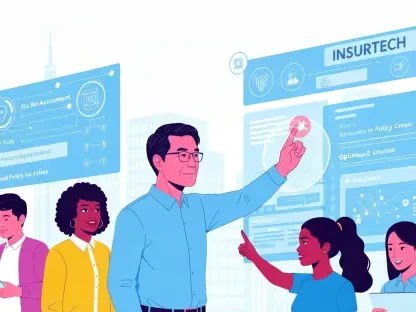In an era where digital innovation shapes every facet of daily life, the insurance industry finds itself at a critical juncture, needing to adapt swiftly to keep pace with soaring customer expectations and internal challenges. Consumers, accustomed to the instantaneous, personalized services offered by tech giants, now demand the same level of efficiency and transparency when filing claims—a pivotal interaction that often determines their trust and loyalty toward an insurer. Meanwhile, the sector grapples with a shrinking workforce, as many experienced claims adjusters approach retirement and fewer new professionals enter the field. Technology emerges as a powerful ally in this landscape, offering tools like artificial intelligence (AI), automation, and aerial imagery to streamline processes while preserving the essential human connection at the heart of claims. This exploration delves into how these advancements address both operational inefficiencies and emotional needs, ensuring that insurers can deliver on their fundamental promise of support during moments of vulnerability.
Navigating Modern Pressures in Insurance
Meeting Heightened Customer Standards
The bar for customer service in insurance has been set extraordinarily high by seamless experiences in other industries, where speed, clarity, and personalization are the norm. When a claim is filed, often during times of distress, any delay or miscommunication can fracture the fragile trust between insurer and policyholder. Technology offers a pathway to meet these expectations by enabling faster responses and clearer updates throughout the claims journey. For instance, digital platforms can provide immediate acknowledgments and status tracking, reducing anxiety for customers awaiting resolutions. Insurers adopting such tools not only prevent dissatisfaction but also position themselves as reliable partners, turning a potentially negative experience into a foundation for long-term loyalty. The urgency to integrate these solutions is clear, as failing to adapt risks alienating a consumer base that increasingly values efficiency over traditional methods.
Beyond immediacy, personalization plays a crucial role in satisfying modern policyholders who expect interactions tailored to their unique circumstances. Advanced data analytics and AI can sift through vast amounts of information to offer customized communication, ensuring customers feel understood rather than processed. This capability becomes especially vital during high-stress claims, such as those following natural disasters, where a generic response can feel dismissive. By leveraging technology to anticipate needs and deliver relevant updates, insurers can foster a sense of being cared for, which is often just as important as the financial payout. The shift toward such individualized service reflects a broader trend across industries, where technology bridges the gap between mass operations and personal touch, redefining what it means to be customer-focused in the insurance space.
Addressing a Diminishing Workforce
A significant challenge facing the insurance industry is the declining number of claims adjusters, compounded by projections from the U.S. Chamber of Commerce that a large segment of the current workforce may retire within the next 15 years. This looming talent shortage threatens to overwhelm traditional, labor-intensive claims processes that rely heavily on manual effort. Technology steps in as a critical solution, automating repetitive tasks to lessen the burden on existing staff while making roles more appealing to younger, tech-savvy professionals. By reducing the grind of paperwork and routine data handling, insurers can redefine the adjuster position as one focused on strategic problem-solving and customer care, potentially attracting fresh talent to an otherwise shrinking field.
Moreover, the integration of digital tools offers a chance to upskill the current workforce, preparing them for a future where technology is integral to their daily tasks. Training programs centered on using automation and AI not only enhance efficiency but also boost job satisfaction by allowing adjusters to engage in more meaningful work. This shift is essential for retention, as employees are more likely to stay in roles that challenge and develop their abilities rather than confine them to monotony. As the industry looks ahead, creating an environment where technology supports rather than supplants human effort will be key to navigating workforce gaps. The focus must remain on designing roles that leverage digital advancements to empower staff, ensuring the claims process remains both sustainable and human-centered amidst these demographic shifts.
Harnessing Technology for Better Claims Outcomes
Revolutionizing Efficiency through Automation and AI
Automation and AI are rapidly reshaping the claims landscape by taking over time-consuming, repetitive tasks that once bogged down adjusters, such as data entry and initial claim routing after a first notice of loss (FNOL). By cutting response times from several days to mere hours, these technologies ensure that customers receive prompt attention, a factor critical to maintaining trust during stressful periods. This efficiency also frees up adjusters to concentrate on complex cases and direct customer interactions, where their expertise and empathy can make the most impact. The result is a dual benefit: policyholders experience quicker resolutions, while staff can dedicate their energy to high-value activities, transforming the claims process into a more agile and responsive operation that meets contemporary demands.
Additionally, the precision of AI in handling tasks like document collection and fraud detection adds a layer of reliability to claims processing that manual methods often lack. Algorithms can flag inconsistencies or potential issues early, allowing adjusters to investigate further without starting from scratch. This not only speeds up the overall workflow but also enhances accuracy, reducing the likelihood of errors that could delay payouts or damage customer confidence. As insurers continue to refine these tools, the potential for even greater time savings and quality improvements becomes evident. The shift toward automation signifies a broader move away from outdated systems, positioning technology as an indispensable partner in scaling operations without sacrificing the quality of service that policyholders expect.
Accelerating Recovery with Advanced Assessment Tools
In the aftermath of catastrophic events, the ability to assess damage swiftly and accurately can make all the difference in delivering timely aid to affected policyholders. Technologies such as aerial imagery and high-resolution property data enable insurers to evaluate widespread destruction remotely, often within hours of a disaster. This rapid response capability ensures that resources and support are directed to those in greatest need first, streamlining the recovery process. By bypassing the delays of traditional on-site inspections, these tools not only expedite payouts but also demonstrate a commitment to customer welfare, reinforcing trust at a time when it matters most and setting a new standard for post-disaster claims handling.
Furthermore, the use of such advanced assessment methods allows for a more equitable distribution of assistance by providing a comprehensive overview of impacted areas. Insurers can prioritize claims based on severity, ensuring that the hardest-hit regions or individuals receive attention without unnecessary wait times. This approach also minimizes the logistical challenges of deploying adjusters to hazardous or inaccessible locations, enhancing safety for staff while maintaining service continuity. The adoption of these technologies highlights a pivotal shift in how the industry responds to crises, moving toward solutions that balance speed with compassion. As natural disasters become more frequent, investing in such innovations will be crucial for insurers aiming to uphold their role as dependable protectors in the face of adversity.
Keeping Humanity at the Core of Claims Innovation
Strengthening Connections through Empathetic Tech
During moments of loss or crisis, customers seek more than just financial compensation; they need reassurance and understanding from their insurers. Technology plays a vital role in enabling this by equipping adjusters with tools that capture interaction context and track sentiment during communications. Real-time insights allow staff to tailor their responses, addressing specific concerns with empathy and precision, which can transform a routine claim into a deeply supportive experience. For policyholders, features like instant updates on claim status alleviate uncertainty, fostering a sense of being valued. This synergy between technology and human touch ensures that even in a digital age, the emotional needs of customers remain a priority, strengthening the bond with their insurer.
Equally important is the impact of these tools on adjusters, who often face high-pressure environments while managing multiple claims. By automating background processes and providing actionable data during customer interactions, technology reduces stress and allows staff to focus on delivering personalized care rather than juggling administrative tasks. This shift not only improves the quality of service but also enhances job satisfaction, as adjusters can see the direct impact of their efforts on customer outcomes. The result is a more motivated workforce, better equipped to handle the emotional nuances of claims. As the industry evolves, ensuring that technology supports rather than hinders these human interactions will be essential for maintaining the trust and loyalty that define successful insurer-customer relationships.
Building a Framework for People-Centric Innovation
The adoption of technology in claims processing must be guided by a commitment to prioritize the needs of both customers and staff, ensuring that tools genuinely improve experiences rather than complicate them. A fundamental question for any new system should be whether it simplifies life for policyholders and adjusters while enhancing team capabilities. Without this focus, there’s a risk of introducing solutions that create friction or disengagement, particularly if training and trust within teams are neglected. A people-first framework demands robust support structures, including continuous learning opportunities and open communication, to align technology integration with human strengths. This approach ensures that innovations serve as enablers, amplifying the empathy and judgment that remain irreplaceable in claims work.
Moreover, cultural alignment within organizations plays a critical role in the successful rollout of technological advancements. Building trust among adjusters through transparent discussions about how tools will enhance rather than replace their roles helps mitigate resistance to change. Training programs tailored to bridge skill gaps further ensure that staff feel confident using new systems, preventing inefficiencies that could undermine customer service. Engagement at every level fosters a sense of ownership over these changes, turning potential challenges into opportunities for growth. Reflecting on past implementations, insurers that embedded this human-centric ethos into their strategies often saw smoother transitions and better outcomes, proving that technology’s true value lies in its ability to elevate the people it serves.
Reflecting on a Human-Driven Digital Shift
Looking back, the journey of integrating technology into insurance claims revealed a profound truth: while digital tools reshaped efficiency and responsiveness, their greatest impact came from empowering human connection. Automation and AI tackled the mundane, allowing adjusters to focus on empathy and problem-solving, while innovations like aerial imagery ensured swift aid after disasters. These advancements addressed immediate needs, from slashing response times to personalizing customer interactions, and tackled long-term challenges like workforce shortages. As the industry navigated this transformation, the emphasis on trust, training, and engagement proved indispensable in aligning technology with human values. Moving forward, insurers should continue to evaluate tools through a people-first lens, ensuring they enhance rather than eclipse the personal touch that defines claims. The next steps involve deepening investments in training and exploring emerging technologies that further streamline operations without losing sight of compassion, securing a future where insurance remains a pillar of support in times of need.









